A simple, easy, rustic and hearty Vegan Roast that's sliceable, ultra-tender and full of flavour. Just perfect for serving with copious amounts of gravy, roast potatoes and stuffing. Leftovers are great in sandwiches, too!
FEATURED COMMENT
"I admit I was unsure about this recipe, but was fascinated by the promise and decided to give it a go. It is truly amazing - I'm not even a vegetarian, but my wife is, and I have to say it tastes great and has a remarkable meaty consistency. Very easy to make - follow the instructions, and out it comes, exactly as promised. Thank you very much!" - Simon ⭐️⭐️⭐️⭐️⭐️ More reviews →

💌 SAVE THIS RECIPE!
Watch out for more tasty treats coming your way too! Unsubscribe at any time.
'Tis the season of gathering around the table and feasting on delicious food, and I am always in need of simple, manageable, festive recipes that still feel a bit special. And this vegan roast recipe is all of that.
It makes the perfect centrepiece for your Thanksgiving and Christmas dinners. Don't forget the cranberry sauce, and be sure to slice up any leftovers because it makes great lunch meat/cold cuts for sandwiches and salads, etc!
Like my vegan chicken breasts and vegan ham, this homemade turey-style seitan is super easy to make, and you can prep it and shape it up to 3 days ahead, leave it in the fridge, then cook it on the day, or even in advance. Don't you just love recipes that take the pressure off?
It's also way cheaper to make than pre-made vegan roasts and is a great alternative to Thanksgiving turkey or Tofurky. If beef is more your thing, though, check out my amazing vegan beef recipe!
Mel x
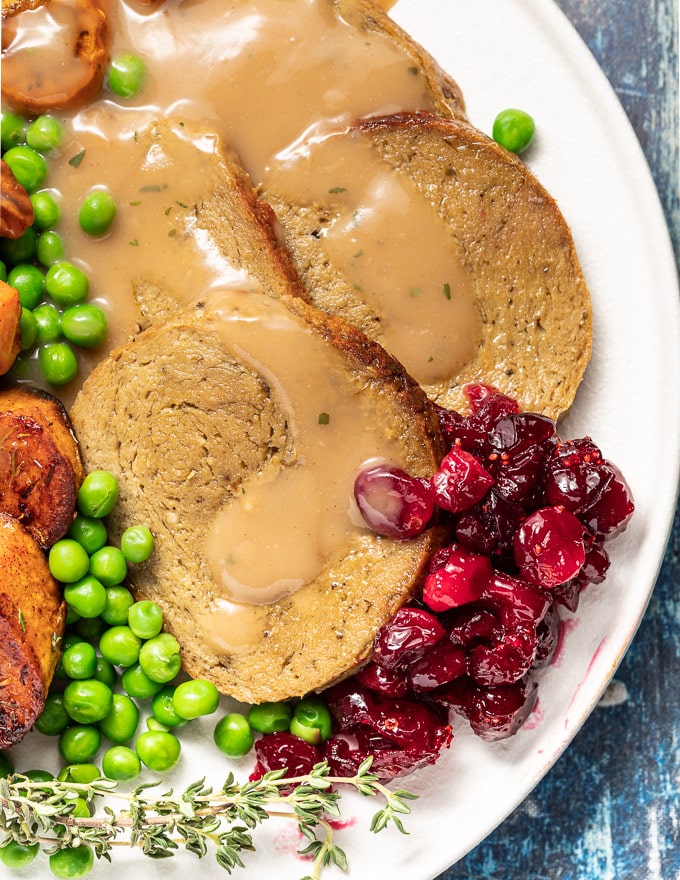
Ingredient Notes
So, let's get down to business. Here's the rundown on what's going on in this vegan seitan roast and why:
(For detailed measurements and instructions, see the printable recipe card).
- Vital wheat gluten - Vital wheat gluten is what gives this vegan roast its meaty texture and is an absolutely essential ingredient in this recipe. It absolutely cannot be made without it.
- White beans - Any canned white beans will work. They add moisture to the recipe and keep the roast tender.
- Artichoke hearts - These should ideally be the ones packed in oil for the very best flavour, but the canned ones in water will work too. I haven't tried it but I think you could probably get away with using uncooked mushrooms and a tablespoon of oil instead if you wanted to.
- Nutritional yeast - For depth of flavour. I promise your roast will not taste cheesy!
- Sage, rosemary, thyme, garlic, pepper - All the flavour givers to cover up that unique vital wheat gluten taste.
- Tamari or soy sauce - For "meaty" flavour
- Stock - again for flavour and moisture. For this recipe I love to use 2 tablespoons of Better Than Bouillon No Chicken Base mixed with the water. It has a chicken-y type flavour that works so well in a roast like this. If you can't get that, though, any good tasting stock will do.
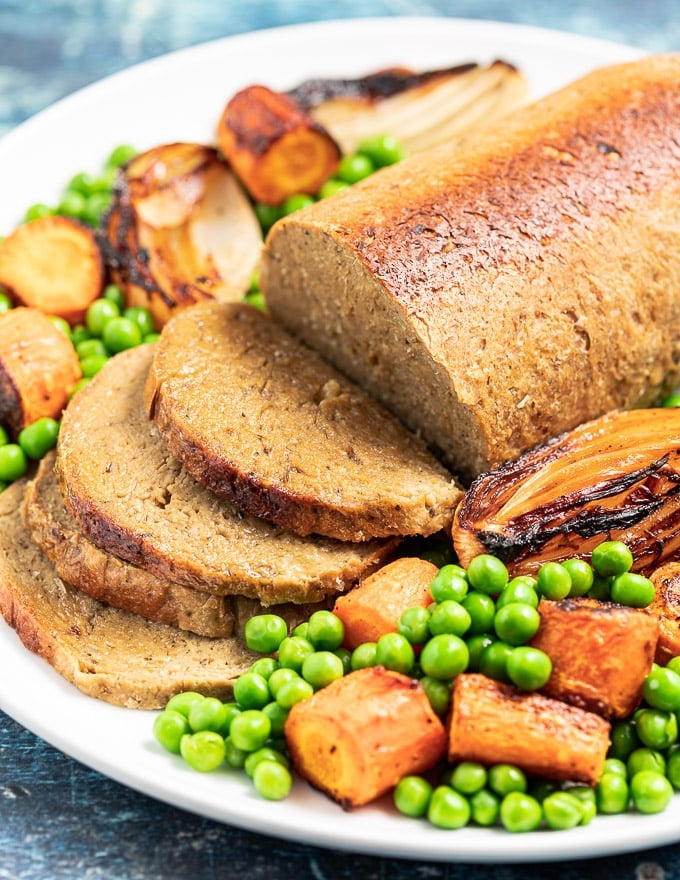
Seitan Tip
For the best results when making seitan, weigh the vital wheat gluten on a digital kitchen scale. Cup measurements are not accurate enough when measuring flour-like substances, and if you use too much, it will greatly affect the texture of the finished roast. If you must use cups, spoon the vital wheat gluten into the cups without compacting or shaking down, then level with a knife. Do not scoop it up, or you will end up using way too much.
Let's Make A Vegan Roast
Can't wait to make it? The full printable recipe is below, but first, let me walk you through the steps to set you up for success in your kitchen. If you're more of a visual learner, watch my recipe video.
Add all of the ingredients except the vital wheat gluten to a food processor and blend them up.

Add the vital wheat gluten and pulse until a rough dough is formed.
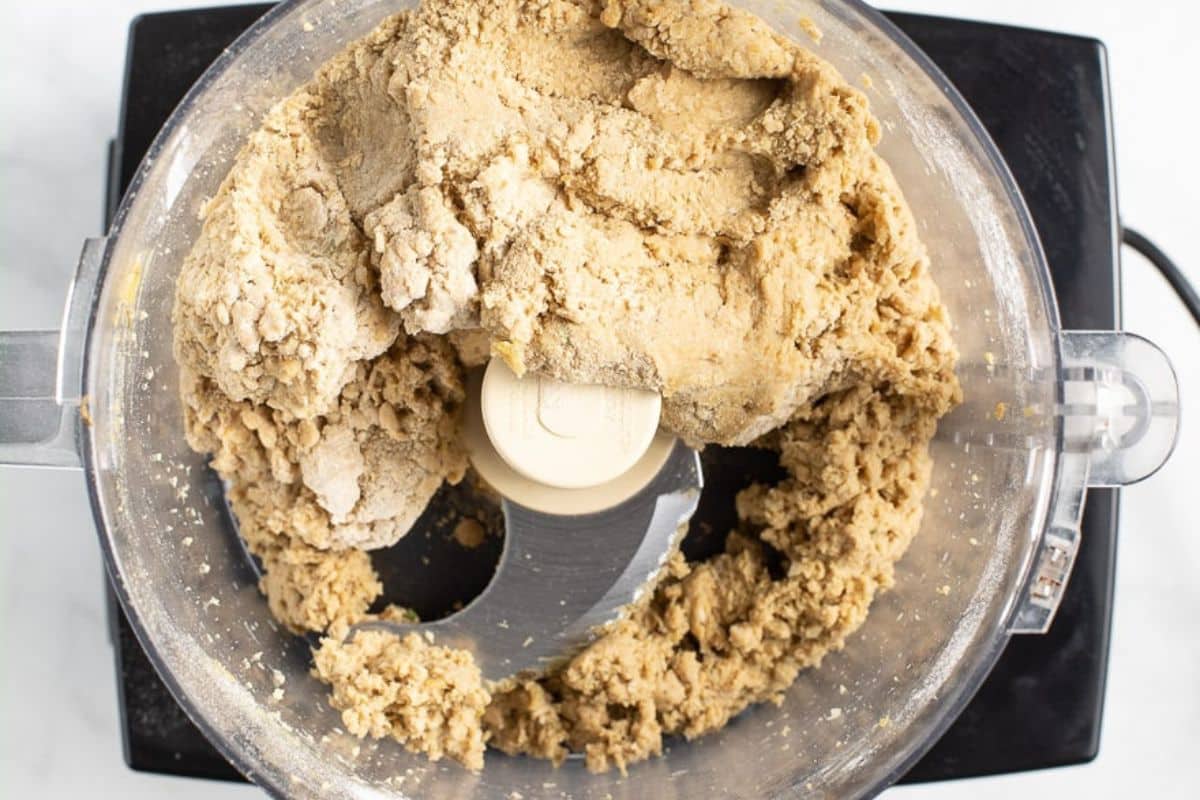
Knead until it looks fibrous. Don't skip this step. Some seitan recipes come out tough as old boots if you knead them too much and I don't want you to be scared of that. I promise that as long as you follow my recipe exactly, this one won't. Even if you get carried away and knead it way more than called for it will still be beautifully tender.
This is how it should look:
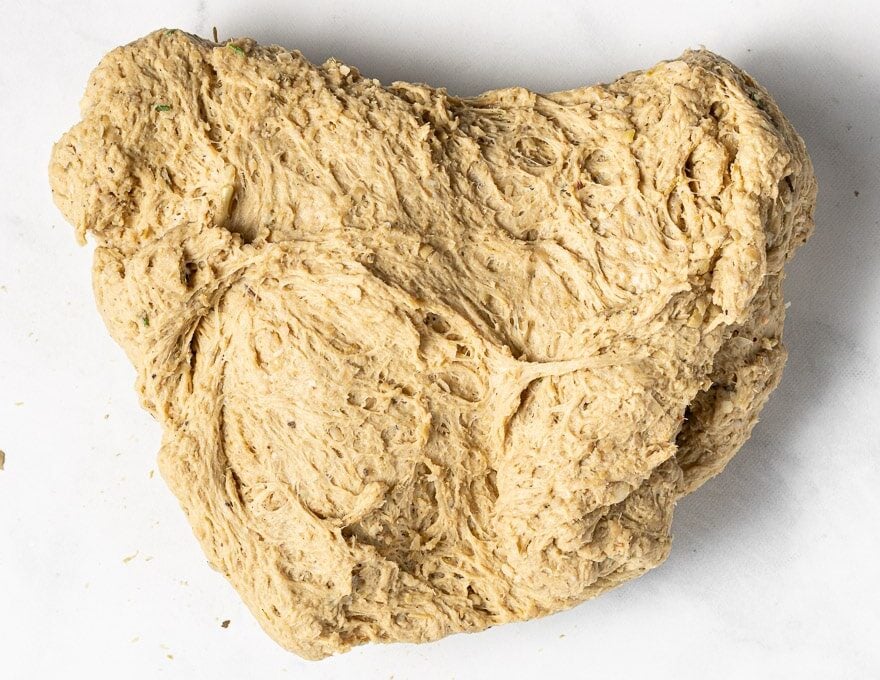
Shape into a log, roll up like a Christmas cracker in foil, then bake.
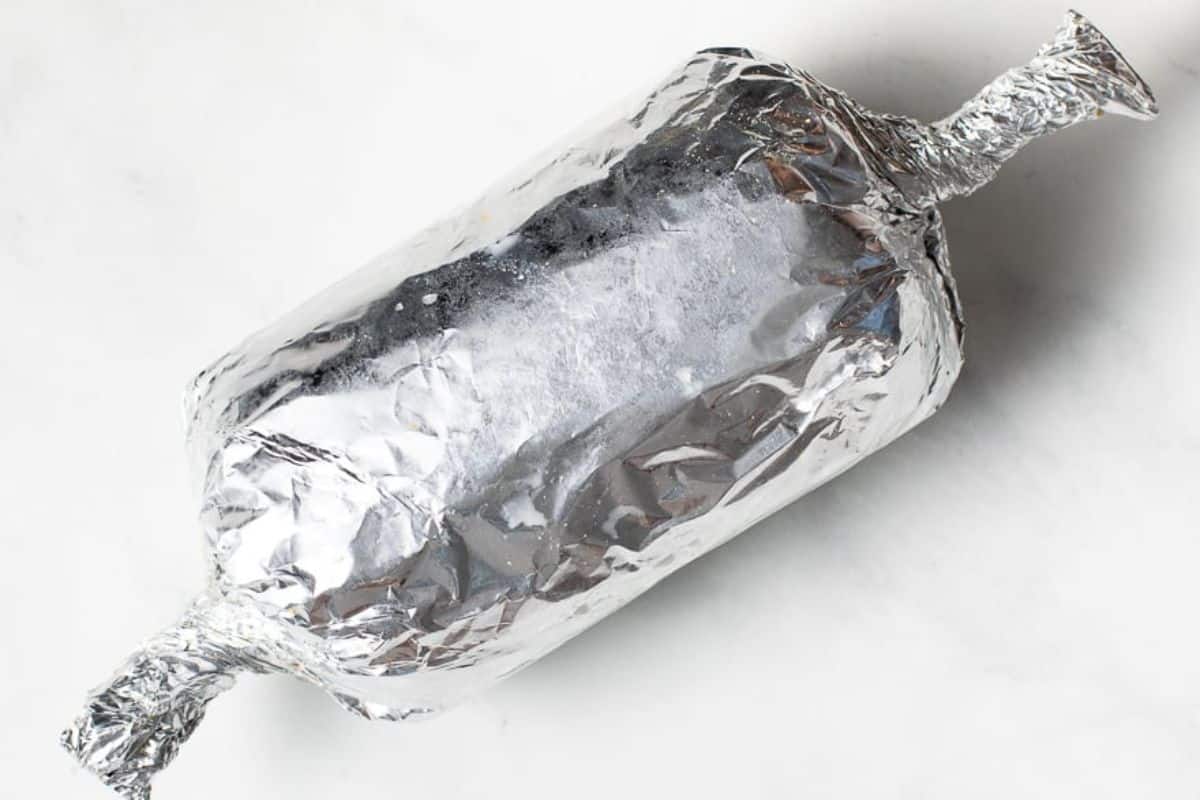
You just made your own vegan roast, you little genius you!

Recipe FAQs
Vital wheat gluten is made from wheat flour which is hydrated to activate the gluten, the main protein in wheat. Then everything but the gluten is removed. The gluten is then dried and ground back into a powder. It's the main ingredient in seitan recipes like this one, but is also great when used as a binder in vegan meatloaf and burgers. I use it in the "meatball" recipe in my cookbook Vegan Comfort Cooking. It's also a useful ingredient in bread recipes. Just a tablespoon or two in a loaf can improve the texture and elasticity of dough, which in turn helps improve the rise, crumb and the crust. It's especially useful when making bread with lower protein flours such as wholewheat and rye. Vital wheat gluten pretty cheap to buy although not all grocery stores carry it. I buy mine from Amazon. This is the one I used to make my seitan. It's incredibly good value for a great big bag and it's non GMO. Pour it into an airtight container and leftovers will keep for ages and ages.
This recipe does need to be wrapped in foil to cook properly. If you try without it, it will dry out. If you prefer the foil not to come into contact with your food, wrap the roast in baking parchment paper (not wax paper) first, and then cover that tightly in the foil.
Recipe

Vegan Roast
Author:WATCH HOW TO MAKE IT
Ingredients
- 1½ cups (270 grams) canned white beans , drained & rinsed (such as white kidney, lima, great northern, or cannellini)
- 1 cup (200 grams) artichoke hearts , ideally packed in oil but in water is fine too. Squeeze gently to remove excess liquid before measuring.
- 4 cloves garlic
- ¼ cup (28 grams) nutritional yeast
- 2 tablespoons (30 ml) soy sauce or tamari
- ½ teaspoon ground black pepper
- ¾ teaspoon rubbed sage , or ½ the amount of ground sage
- ¾ teaspoon fresh or dried rosemary
- ¾ teaspoon dried thyme
- 2 tablespoons Better Than Bouillon No Chicken Base , or ½ cup of strong tasting veg/mushroom stock instead of the Better Than Bouillon & water.
- ½ cup (120 mls) water
- 2 cups (256 grams vital wheat gluten
RECOMMENDED EQUIPMENT
INSTRUCTIONS
- Preheat oven to 400°F (200 °C).
- To a food processor, add the beans, artichoke hearts, garlic, nutritional yeast, soy sauce, black pepper, sage, rosemary, thyme, Better Than Bouillon No Chicken Base, and water. Process until well combined and smooth-ish. If you don't have a food processor, blend in a blender or with an immersion blender.
- Add the vital wheat gluten to the food processor and pulse until a rough dough starts to form, then tip out onto a clean surface. If you don't have a food processor, add the liquid mixture and vital wheat gluten to a mixing bowl and stir, then knead together, until a rough dough is formed.
- Knead for 7 minutes. By the time you have finished kneading, the dough should look fibrous. See my picture in the post above as a guide. If it isn't, knead for a few minutes more. Don't worry about overkneading. It will be fine.
- Shape the dough into a log shape roughly 8½ inches long and 4 inches wide.
- Get a long piece of foil (around 20 inches long) and place the roast right at the end of it, long side of the roast along the shortest side of the foil. Roll it up in the foil. Keep rolling it until you reach the end, so that the roast is surrounded by a few layers of foil. Then twist each end tightly shut so it looks like a Christmas cracker.
- Place the foil wrapped roast onto a baking tray and place on the middle shelf of the oven and bake for 35 minutes. Turn it over and bake for another 35 minutes. Remove from the oven. Leave it to rest in the foil for at least 30 minutes before opening and slicing. It will stay warm for a few hours if you don't unwrap it.
NOTES
💌 SAVE THIS RECIPE!
Watch out for more tasty treats coming your way too! Unsubscribe at any time.



Barbara Mikk says
Fantastic! Made this tonight for Christmas and it was FANTASTIC! Served with a light gravy flavored with onion and sage. Thank you!!
Whack says
Hi Melanie,
Is "Vital Wheat Gluten" the same as "Vital Wheat Flour?"
We're new to this, but trying hard...
Thanks in advance
---Whack
Melanie McDonald says
Yes it's the same.
Ruchama says
Most of the artichokes in cans we can buy are not in oil. They are in water. I would think they would be fine. But before I waste a lot of good ingredients, please let me know.
Melanie McDonald says
I buy them in jars. Then they tend to be packed in oil rather than water. The ones in oil tend to have spices and herbs added so are more flavourful. That's why they are recommended for this, but the recipe will work fine with the ones in water too.
Ruchama says
Thanks. We keep a kosher home and I haven't seen any jarred artichokes that a certified kosher. I'll check around. Otherwise, I can just add some seasoning to the canned ones. Which would you suggest: poultry seasoning, Italian seasoning?
Troy says
Excellent. Paired with mushroom gravy. Very good.
Keith Stewart says
This is one of my favourite recipes and I make it often. Tonight for something different I divided the dough into 16 pieces and rolled up in the foil, 16 delightful little bangers. The baking time was reduced to 20 minutes. Browned in a skillet and served with mashed and a veg, I am a happy man. Thanks
A Virtual Vegan says
Ooo love that idea! They sound perfect!
Rosie says
I made this recipe the other day. I couldn’t believe how easy it was and how well it turned out. I couldn’t get any artichokes, so I decided to try the same weight of fresh mushrooms instead. Also, I couldn’t get the Bouillon paste, but added Organic Swiss Bouillon powder (2 tsp) to the water (I boiled the water first and then added the powder and mixed it in before adding to rest of ingredients). Going to give some leftovers to my son and his fiancée, who are both vegans. But it’s great to know that I can keep it for a week in fridge and also freeze what I don’t use - always handy for last minute dinners. Thanks Mel.
A Virtual Vegan says
I'm really pleased you enjoyed it Rosie!
Bronte Marshall says
Hello there,
I love the sound of your recipe and I am excited to bake and try it!! Thank you for providing it!!
I was just wondering your recommendation if I were to half the recipe? (As I was thinking of making a batch and giving half to my friend who is also the only vegan in her family)
Look forward to hearing from you and I hope you are as excited for Christmas as I am!!
-Bronte
A Virtual Vegan says
It should be fine. Keep both pieces in a log shape about 4 inches in diameter and the cooking time shouldn't change too much. I'd just knock off 5 minutes I think. It keeps well for a week in the fridge and can be frozen once cooked too so it's great for giving to someone. Merry Christmas!
Bronte Marshall says
Oh lovely! Thank you so much!!
Merry Christmas to you too!!
Georgina Lamb says
Is there a sub for artichoke hearts?
A Virtual Vegan says
I've enver tested it with anything other than the artichoke hearts. They really are the best thing to use because of their flaky texture, flavour and colour.
Dawn says
Is it possible to freeze it before baking? I’m working next week and won’t have time to make it in the 3 nights before Christmas! Thanks ?
A Virtual Vegan says
I've never frozen it before baking so I don't know how it would turn out. It's great made ahead though and would be fine in the fridge for up to a week. It can also be frozen with no problems once it's been baked.
Carol Bryan says
I just made this recipe for last night. My husband had bought an exceptional bottle of red wine for a special dinner so I made the roast. We thought it would taste better with a beef focus rather than turkey or other poultry so I adjusted the recipe slightly. I left out the sage and used "Better Than Bouillon No Beef" rather than "No Chicken." The roast was spectacular and was darker brown and had more of a beef flavor. We had roasted potatoes and Red Wine Gravy along with veggies. It was wonderful.
A Virtual Vegan says
I'm really pleased you enjoyed it Carol! Your meal sounds delicious!
Nicola says
Is there a way to make this recipe gluten free? Or for your gluten free roast recipe can I add artichokes and/or beans? I like the ideas of the flavours in this recipe a bit better than the gluten free recipe version. Looks great thanks!
A Virtual Vegan says
I wouldn't try making this recipe gluten-free. It took me months to perfect my gluten-free roast. There are no straight swaps. It would be much better to make my already GF recipe.
Regarding the GF one, you could probably use artichokes instead of the mushrooms. Be sure to squeeze them out well to get most of the liquid out of them. I'd suggest the marinaded ones in oil rather than brined for max flavour. I wouldn't recommend using beans in the GF one. I had to work really hard to get a decent texture. Beans make it way too smooth and pate'ish and they don't have much flavour either.
Keith Stewart says
Thanks for this recipe. My doctor has put me on a vegan diet because of high cholesterol. I made this roast tonight and it is fantastic. There are lots of leftovers which is a good thing because I could eat it every night.
A Virtual Vegan says
I'm really pleased you enjoyed it Keith and best of luck with lowering your cholesterol!
Cherri says
Are the marinated artichoke hearts what you use? Those are the only ones I can find in oil.
A Virtual Vegan says
They are fine. They'll add some extra flavour!
Lindsey says
Hi there!
I’m excited to try this recipe out as a replacement for the Quorn roast. :-) I’m curious if olive oil poached mushrooms or jarred palm hearts could replace the artichoke hearts?? (Trying to use what I’ve got b4 buying other stuff.)
Thanks for sharing your creation!
-Linds
A Virtual Vegan says
I haven't tried either in this recipe so I'm not sure how they would affect the flavour or texture. If you try it though let us know how it turns out!
James says
How sticky should the dough be when kneading? Should it be like a bread dough or more to the sticky side?
Melanie McDonald says
Not sticky. A bit tacky. When kneading it feels kind of like tough bread dough.
Lacey says
Phenomenal recipe! I even used artichokes in brine and added capers to make up for some flavor. I also used a lot of spices and added a drop of liquid smoke. It was my first time kneading so I felt like I had no idea what I was doing and it still came out tender and delicious! The hubby is even surprised it looks like meat! Its so easy and with your onion gravy from your book, this recipe is now on our rotation. Thank you so much!!
Melanie McDonald says
Thank you Lacey! I'm really pleased you both enjoyed it and thanks so much for stopping by to leave a review. It's much appreciated!
Maria says
I measured out the vital wheat gluten using cups instead of a scale. I haven't cooked the roast yet. Unfortunately, I missed the part that says only use a scale. Now I'm wondering if it will be ruined
A Virtual Vegan says
It doesn't say to only use a scale. It says "for the best results weigh the vital wheat gluten". I always recommend a scale for measuring flour-like substances in my recipes because cups are notoriously inaccurate. Every single time you fill a cup it will be holding a different weight and it can really affect how recipes turn out. Also people don't tend to use measuring cups correctly. Some scoop the ingredient up into the cup which means they will end up with up to a third more than was intended. The only way to be accurate is to use a scale.
Regardless though, as long as you measured with the measuring cup as they are intended to be used (by spooning the VWG in and scraping the top with a knife without shaking/compacting it down, you should have just about the right amount and the recipe will be fine. Even if you used too much in this recipe it won't ruin it. You'd just need to add a little more liquid to make the dough come together. Hope that helps.
Heather Bright says
Well this is a game-changer! Loved it, so simple and I'm looking forward to using the leftovers.thank you so much for this recipe, it will be well used.
Lana Anderson says
I made this for supper yesterday. It was a hit! Excellent flavor! I did not have artichokes in oil, so had to use artichokes in brine. It was still delicious. I will buy the artichokes in oil for next time. What is the reason to use artichokes in oil? Less salt?
A Virtual Vegan says
I'm glad you enjoyed it Lana! I prefer the artichokes in oil because that little bit of oil residue on them that ends up included makes the roast a bit more moist and tender, plus the ones in oil taste better. The oil itself adds flavour and they are usually marinated in herbs etc too so add much more flavour to the roast. Also as you said, the ones in brine can make it all a bit salty. The Better Than Bouillon or stock and soy sauce are necessary for good meaty flavour but they are also quite salty. The recipe doesn't need more on top of that. Hope that helps!
Lana Anderson says
Thanks so much!
Cyndy says
This recipe sounds amazing! Do you know if there is any adjustment to cooking time or temperature for high altitude? I want to make this for Christmas dinner but we will be in the mountains at 7200ft. I’m a little worried it might not be cooked correctly and won’t know that until I open the foil. BTW your attention to detail and comments within this recipe are very helpful. They give me the confidence to try this. Thank you!
A Virtual Vegan says
I'm sorry but I have no experience of cooking at high altitude, but I did just Google and according to this source (and a few others I looked at) https://www.eatright.org/homefoodsafety/four-steps/cook/cooking-guide-for-high-altitudes , high altitudes don't really affect oven-roasted meats etc and sea level instructions should apply still, so that should be the same for this. It's only when boiling, grilling, frying and baking with leaveners and yeast that it makes a big difference. The altitude doesn't affect the oven temperature and there are no leaveners or yeast involved so I'd just bake it as per the recipe. You might however need an extra tablespoon or two of liquid to get the dough to come together. You are looking for a stiff, quite tough to knead, dough. Hope that helps!
Nina says
Hi Mel and greetings from the UK. Thanks for the fabulous recipe and video ( so helpful) my food processor broke down on me yesterday. (new food processor on order) I have all the ingredients to make this. Could I use my Vitamix or Mini blender to blend some of it together? Also can I use my Kitchenaid to knead the dough with the dough hook. If so would I knead it for the same length of time? Many thanks. I love it that you test your recipes so well. I have just purchased your cookbook. Love it.., sending you a virtual ?
A Virtual Vegan says
Hi there Nina and thank you! You can definitely blend the first part up (minus the vital wheat gluten) in your Vitamix. Then scrape it out into your KitchenAid and add the VWG. Luckily with this recipe, unlike other seitan, it's very hard to over-knead it because of the high proportion of beans and artichokes to VWG. I tried and it made little difference to the outcome so you'll be fine doing it in the KitchenAid. I'd go for 4 minutes kneading in there or when it looks fibrous and stringy like the picture in my post.
Hope you enjoy it!
Kerrie says
Love this recipe!